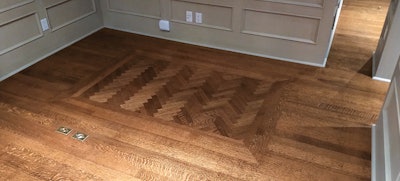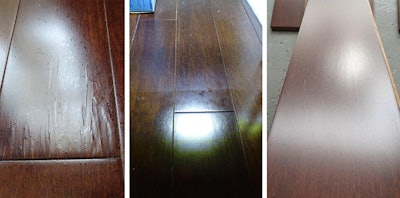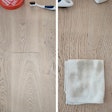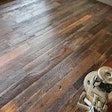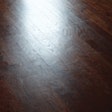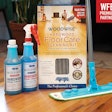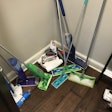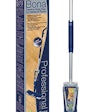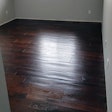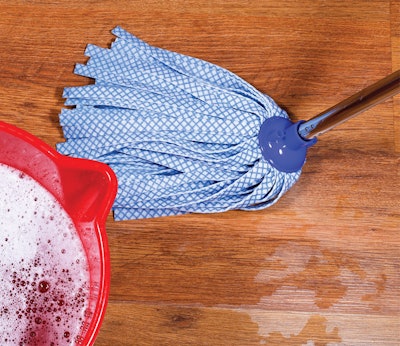
We asked our followers on social media: What confuses your customers the most about wood floors? Not surprisingly, we had no shortage of passionate responses. It's a pro's job to educate the customer about what's involved, but there's a lot for consumers to take in trying to understand everything involved in a professional wood floor job from start to finish.
In the following pages, we compiled some of the most common responses about consumer wood flooring confusion, including actual quotes from those wood floor pros. Our hope is that the information in this article can help you educate your own customers, preventing frustration all around.
 Species that are relatively low on the Janka scale, like this yellow birch floor, will show more denting than harder species.
Species that are relatively low on the Janka scale, like this yellow birch floor, will show more denting than harder species.
WOOD HARDNESS
What confuses them:
"Expectations about hardness—walnut does not belong in a house full of children and big dogs, for example."
It happens all the time (as I've written about before, I did it in my own house!): People end up with a species that isn't suitable for their lifestyle. In my case, we installed a beautiful yellow birch floor that looked fantastic—until our family adopted an exuberant 80-pound Labrador. Few people in the world would be diligent enough about dog claw trimming to protect a birch floor from the damage a dog like ours can inflict on a relatively soft wood (we certainly haven't been, as you can see in the photo above). But we can see a drastic difference in how much damage he does on the birch compared with the old existing white oak floor in our kitchen.
The reason for that difference is the wood's Janka hardness. In the laboratory, the Janka test measures the force required to embed a 0.444-inch-diameter steel ball halfway into a sample of wood. Yellow birch has a hardness of 1,260, while white oak has a hardness of 1,360. Some exotic woods have a hardness over 2,000. The Janka test gives you a good general idea of how readily different species may dent—with some caveats:
1) For engineered flooring, the thickness of the veneer is important. If a floor has a thin veneer, the core material hardness is more significant for dent-resistance than the Janka rating of the wear layer species.
2) As a pro wrote on our Facebook page, "The term 'hardwood' does not equal 'indestructible.'" The Janka test uses a round ball, not something pointy. Even wood species with a high Janka rating are helpless against a stiletto, for example, which can pulverize concrete. Rolling a piano or a refrigerator is going to dent almost any wood floor.
Choosing a harder species helps prevent dents, and some additional choices that can help disguise wear include distressed floors, as well as species and grades of flooring that have character and grain: Wear won't be as obvious on a No. 1 red oak floor as it will be on a clear maple floor.
In summary:
The floor species and type must be chosen with the customers' lifestyle in mind, not just aesthetics.
FINISH HARDNESS
What confuses them:
"Putting down commercial-grade finish on fir isn't suddenly going to make it as hard as maple."
There are so many finish options right now, and a big upsell for many contractors is offering harder commercial-grade finishes. Along the way, some consumers end up with the mistaken impression described in the quote above—that having a higher-quality finish will make the floor itself impervious to just about anything and will somehow make the wood itself harder. Of course, that isn't possible. In the case of my floors, the finish itself (a high-quality commercial-grade waterborne finish) has held up. It's the actual wood that is dented everywhere (as shown in the photo on this page). Most consumers are not going to make that distinction—they just care if the floor looks good or not.
In summary:
Using a commercial-grade finish makes the finish itself more durable—resistant to scratching and wear—but it can't make the wood harder. If wood dents, its finish will dent with it.
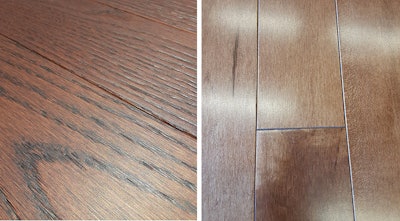 The matte sheen and the grain of the prefinished oak flooring at left will disguise wear more than the semi-gloss finish on the prefinished maple at right.
The matte sheen and the grain of the prefinished oak flooring at left will disguise wear more than the semi-gloss finish on the prefinished maple at right.
SHEEN
What confuses them:
"Sheen can make a difference in the color of the floor or how much you see scratches in the floor later on."
"Sheen" means, basically, how shiny a floor is, typically described from matte (not shiny) to satin to semi-gloss and gloss (super shiny). In the coatings world, gloss is measured with a gloss meter, which measures the amount of reflected light from the light beamed at a given angle onto the floor. As noted in the quote above, the sheen can affect the perception of the floor color.
Sheen is also a big factor in how much scratches and wear show up on a wood floor. The glossier the floor, the more obvious wear on the finish will be. Conversely, a low-gloss floor helps disguise scratches and other marks on the finish, making it an ideal choice for clients concerned about seeing finish wear.
In summary:
Sheen can affect the appearance of color and wear, and it's important customers understand that.
 Proper sanding requires many steps with professional products.
Proper sanding requires many steps with professional products.
THE SANDING PROCESS
What confuses them:
"They think all we do is sand it once and stain it. They don't understand grit progression—why it takes as long as it does."
There's a good reason floor sanding is a professional job: It's an involved process that requires many steps and expertise to know which products will work best and how to do it correctly, all with professional sanding machines.
When pros sand a floor, they determine what is the least aggressive grit to make the floor flat. But that is just a starting point—leaving the floor sanded with that roughest grit would leave long scratches in the floor that are like mountain peaks. Going immediately to too fine of a grit just sands off the very top of the peaks, leaving the deep grooves. So pros use a carefully chosen progression of grits to sand the floor correctly to make it flat. After those sandings with the big machine (for the main area of the floor) and the edger (for the perimeter), these days they may use any number of rotary sanders to blend the sanded areas so they have a consistent appearance. Any sanding inconsistencies are highlighted if stain is applied, so a good sanding job is particularly crucial for floors that have any sort of color, such as stain, dye or colored oil finishes.
In summary:
Sanding a wood floor correctly takes lots of time, expertise and professional products.
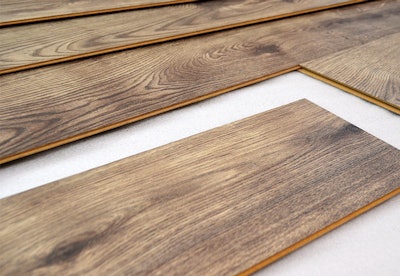 Laminate is a photo of a wood floor on a synthetic base ...
Laminate is a photo of a wood floor on a synthetic base ...
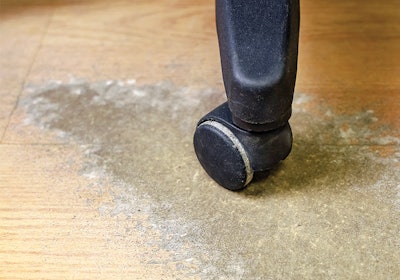 ... so when it's worn, it must be replaced.
... so when it's worn, it must be replaced.
LAMINATE
What confuses them:
"If I get called to another estimate to 'repair' their "hardwood floor" just to find laminate, I may lose my mind!"
It used to be that laminate was the only wood lookalike floor. Now everything from LVT to tile also looks like wood, and consumers are more confused than ever. (For tips on selling real wood versus imitators, see the article "Tips for Selling Wood vs. Lookalike Flooring Products" from the June/July 2020 issue.) Most wood flooring pros can glance at a floor and tell it's laminate, which is a synthetic floor with a photograph of wood on the top. Usually after a few seconds you can spot the repeated boards that have the same wood image on them, although newer laminate products are better than earlier generations about not repeating patterns as much. If a consumer isn't sure by just looking at the floor if it's wood or laminate, if there is a vent they can remove, looking at the cross-section of the flooring should show if it is wood or laminate.
Of course, because laminate is just that—laminate, not real wood—it can't be sanded. As it wears, the image of the wood wears off with it. Because of that, laminate is a disposable floor covering: The only viable option for a worn-out laminate floor is a landfill.
In summary:
Laminate is a synthetic floor, and when it looks worn, it has to go in the trash.
 'Free installation' is like a unicorn—it doesn't exist.
'Free installation' is like a unicorn—it doesn't exist.
INSTALLATION COSTS
What confuses them:
"There is no such thing as 'Free Installation!' This advertisement catch phrase is consumer fraud."
Just like "free lunch," we all know that when it comes "free installation," as they say, "ain't no such thing." Rather, it's a marketing ploy, with the cost of the installation built into other prices or fees on the job. Also, the companies that offer these services (most commonly big box stores) are not known for hiring highly skilled labor, so a wood floor being installed for "Free!!!" is likely not going to be installed by a specialist following all the directions for a successful long-term installation.
In summary:
"Free installation" is like a unicorn—sounds neat but doesn't really exist.
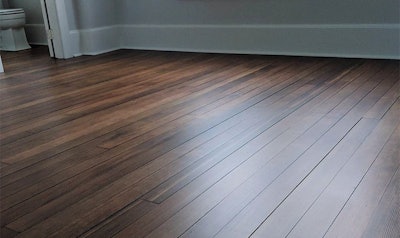 Gaps like these that appear and disappear with the season are considered normal. (Photo courtesy of Bradford Lawson)
Gaps like these that appear and disappear with the season are considered normal. (Photo courtesy of Bradford Lawson)
ACCLIMATION
What confuses them:
"A lot of customers think that letting a floor acclimate is it just getting to the same temperature."
It's hard to blame consumers for not understanding acclimation when there are still a fair number of installers who don't understand it, either. A valid reason is that, unfortunately, for years the industry preached a time frame for acclimation—the wood had to sit on a job site for X number or days or weeks before it could be installed. As wood flooring expert Howard Brickman likes to say, simply, "Acclimation is not a time thing."
So what is it? It's getting the wood to the desired moisture content (MC) before installation. Wood is hygroscopic, meaning it gains and loses moisture to be in balance with the relative humidity and temperature in its environment. Before it's installed, the wood flooring should be at a MC that is close to the average of the MC it will have year-round after installation; that way it shouldn't have drastic changes in dimension as it shrinks or swells to be in balance with the ambient air.
To be clear, some movement in wood flooring with changes in humidity is to be expected. Gaps that appear and then close with the seasons are considered "normal gaps." Because of its construction, engineered flooring has less movement than solid flooring, although it will still change to some degree.
Using a moisture meter is the only way to determine wood's MC at the job site and know if it's ready to be installed (meaning it's within the required range of the target MC) or if it needs to acclimate (meaning it needs to gain or lose moisture before installation, a process that can take considerable time).
An exception to this: The directions for some engineered wood flooring state that the plastic packaging of the flooring should not be opened until the flooring is going to be installed.
In summary:
To avoid future problems, most wood flooring needs to acclimate, meaning it needs to have the right moisture content to be in balance with the long-term humidity and temperature of the building.
 According to the National Association of Realtors, homeowners can recover 106% of the cost of installing a wood floor when selling their home.
According to the National Association of Realtors, homeowners can recover 106% of the cost of installing a wood floor when selling their home.
WOOD IS AN INVESTMENT
What confuses them:
"Real wood and stone floors are an investment that create value."
Wood floors DO tend to be expensive compared with most other flooring types. But it's important that potential clients understand that their wood floors are an investment instead of just money spent. According to the 2019 Remodeling Impact Report from the National Association of Realtors, homeowners can recover 106% of the cost of installing a wood floor when selling their home, and refinishing provides a value that recovers 100% of the cost. The report estimated that installation of new wood floors costs a median of $4,700, but sellers recover $5,000 from the investment.
On a related note, another pro wrote that customers don't understand that "a quality engineered wood product is a lifetime floor unlike other cheap flooring options." Understandably, the world of engineered flooring is confusing for many consumers. Many tend to lump it all together when, in fact, quality ranges from bargain-basement options with thin veneers, inexpensive finish and questionable construction to options with quality construction, a thick wear layer and a durable finish.
In summary:
Money spent on a wood floor is actually recovered in home value.
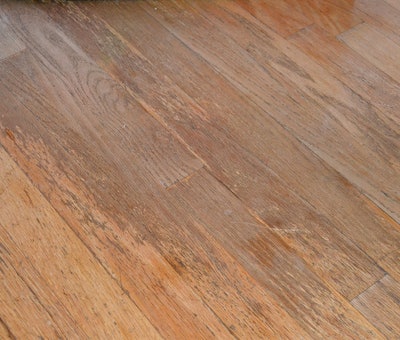 Finish that is completely worn through to bare wood cannot be just recoated.
Finish that is completely worn through to bare wood cannot be just recoated.
A 'LIGHT SANDING'
What confuses them:
"What is a light sanding?"
The concept of the "light sanding" is something of a running joke in the industry because of the number of consumers who ask professional floor sanders if their floors can just have a "light sanding," undoubtedly hoping such a thing will be less expensive. Of course, pros know there is no such option.
When consumers determine that their floors look worn, there are two options:
1) A recoat. That means the floor isn't sanded down to bare wood; instead, the floor is cleaned well and a new coat of finish is applied.
When recoating, there are two options. The contractor can "mechanically" abrade it, meaning use an abrasive to roughen the existing top layer of finish and allow the new coat of finish to bond to it. Or the pro can use a chemical adhesion system that involves a process of cleaning and then application of chemicals that allow the new finish to chemically bond to the old finish.
2) A refinish. With refinishing, the floor is sanded down to bare wood and new coats of finish are applied.
Which is the way to go? If the finish is worn off down to bare wood or the wood has lots of damage (like from the dog claws already discussed), resanding is the only option. If the finish is just looking worn, then recoating is still on the table. Some contractors will only do total refinishes, not recoats, because of the potential for the floor to be contaminated with non-recommended cleaning products or other contaminants (see the section on "Oil Soaps" below), causing problems with finish adhesion.
Consumers often ask if the contractor can just fix the areas that are looking worn out. In the majority of cases, the answer is no. An exception is when the floor has oil finish, such as tung oil or hardwax oil, or wax finish. With those finishes, finish can usually be spot-applied to only the worn areas instead of the entire floor.
In summary:
A wood floor that looks worn might need to be recoated (the finish abraded and new finish applied) or totally refinished (which involves sanding to bare wood and new finish applied) depending on how worn the floor is.
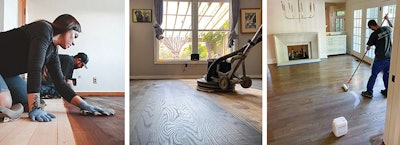 Many consumers are confused about the staining and finishing process: Stain is applied first, usually either with rags (at left) or with a buffer (center), and must dry completely before finish is then applied (at right). (Photos courtesy of, left to right, Staci Martinez, Sydney Lebarron and Daniel Reddy.)
Many consumers are confused about the staining and finishing process: Stain is applied first, usually either with rags (at left) or with a buffer (center), and must dry completely before finish is then applied (at right). (Photos courtesy of, left to right, Staci Martinez, Sydney Lebarron and Daniel Reddy.)
STAIN/FINISH PROCESS
What confuses them:
"Lately, we've had a lot of people confused about the difference between stain and polyurethane ."
If customers don't have any basic experience with stain or finish (on any wood products), they might not be familiar with some of the things that those of us in the industry take for granted as "obvious." The basic staining and finishing process falls into this category, and many pros reported their customers don't know about it. So here goes:
If customers are happy with the color of the wood as-is, we say they're going "natural." In that case, once the floor is sanded, the coating process can begin. For most finishes, that typically means a sealer coat followed by multiple coats of a "topcoat" finish. Dry times between coats vary depending on the actual product.
If the consumer wants the color of the floor to look different than the natural wood color, then the color (most commonly a stain, although other methods are now available) must be applied and dry thoroughly before the sealer and topcoats are applied. An exception is a coating product like hardwax oil that combines color into the finish itself.
In summary:
In most cases, if the floor needs to be a color different than the actual wood, it needs to have stain (or other coloring techniques) applied to it before the finish is applied.
 Wood is created by nature, so it has natural variations.
Wood is created by nature, so it has natural variations.
IT'S NATURAL
What confuses them:
"You are essentially putting a tree in your house. It's natural; you can't dictate exactly how it will look."
One charismatic wood flooring contractor told me that once when a customer complained about the grain of a board in the wood, he told her "you need to call 1-800-G-O-D." With good humor, he was pointing out what everyone in the industry knows: Each piece of wood is unique and a product of nature.
That's a huge selling point, but some customers can be upset about the variation in the appearance of their floors. That's where good samples are critical: The customer needs to see samples that show all the color variation and character that will be included in the grade of the flooring chosen, whether those are mineral streaks, knots, etc.
If customers want zero variation, they need to either buy what wood floor pros might derisively refer to as a "fake floor" or pay an extraordinary premium for wood with that consistent appearance. Customers who are interested in sustainability might be interested to know that lower grades of flooring, which have color variation and character, are generally considered the "greenest" since they use more of the original lumber in the final product.
In summary:
Wood is a natural product, so it isn't reasonable to expect perfect consistency from piece to piece.
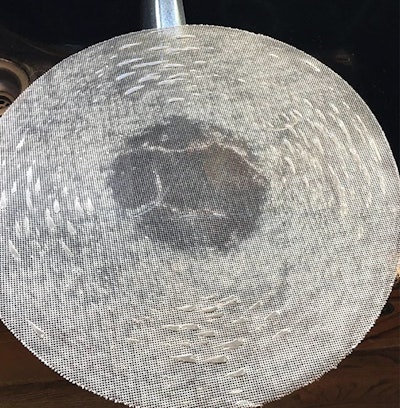 Trying to screen a floor that has been maintained with oil soaps gums up the screen like this. (Photo courtesy of Justin Ball)
Trying to screen a floor that has been maintained with oil soaps gums up the screen like this. (Photo courtesy of Justin Ball)
OIL SOAPS
What confuses them:
"How to clean and maintain them; you can explain it over and over and they will still end up with Murphy's, a steam mop and a garden hose."
As reflected in the quote above, frustration over consumers' unfortunate maintenance choices is commonplace among wood flooring pros, and, along with steam mops (see the sidebar "Steam cleaning a wood floor: accelerated aging in a mop" about steam mops on page 40), oil soaps are top contenders for the worst offense.
Contractors complain that not only do oil soaps make wood floor finish look bad over time (something exacerbated by most consumers' failure to follow the oil soap directions and use the correct dilution ratio), they contaminate the floor when it's time to recoat.
"We will give customers estimates for recoats on the assumption that they have used our cleaning recommendations. After one second with the buffer on the floor, you can tell that it's been used with Murphy's oil soap," wrote Bob Patterson of Robert Patterson Hardwood Floors in Lomita, Calif. "It gums the screen; there is no powder. When you put finish over it you will get many fisheyes where the finish actually runs away from the oil." Patterson added that they always make the customer sign a waiver before attempting a recoat.
Before a recoat, many pros are experienced at snooping through customers' cabinets to see what cleaning products are in the home. "Always look under the sink or pantry. It will tell you what's been used to clean floors," another pro advised. "Most times people use what they want, even if you tell them not to."
Because of the risk of contamination on an existing floor, some contractors simply refuse to do recoats and instead will only do a full refinish.
In summary:
Consumers should use only cleaning products recommended by the finish manufacturer (for a site-finished floor) or the flooring manufacturer (for a prefinished floor). Using non-recommended products can cause issues with recoating the floor.
|
Repairs Are PossibleOftentimes in our industry, "There's no effort to explain that you don't have to throw out an entire old floor because it is damaged," says pro Ron Teljeur of Surrey, B.C.-based Acorn Wood Floors. "The most common phrase, especially at carpet shops, is 'They don't make that anymore.' That comment is rarely true, but if it is, it's likely a current product can be modified to work." Teljeur posted photos of a great example showing that just because an existing floor is damaged doesn't mean it's automatically headed for the dumpster. He explains the job: "This is a 3¼-by-7/16-inch rift-and-quartered red oak solid floor in a luxury downtown Vancouver apartment. I searched for several weeks for boards to replace a urine-damaged spot, and there was no quick delivery or sane price on anything. So, the owner and I came up with the idea to do a feature inlay rather than a spot repair. In the "after" photo, it is stained and the first coat down. This solution was expensive ($100 per square foot) but certainly cheaper than replacing all 1,600 feet. The rent per month is roughly double the $2,500 she is spending on the repair, and now it is a feature in the den alcove." |
|
Steam Cleaning a Wood Floor: Accelerated Aging in a MopBy Michael Purser If you want to figure out how long coatings will last, you accelerate the aging process—by repeatedly exposing them to elements that do it the most harm: UV rays, heat and moisture. You heat them up, then cool them down. You get them moist, then dry them out. You do this over and over again for an extended period of time. When you use a steam mop to clean your hardwood floors, you are heating them and cooling them down. You are getting them moist, then drying them out. You do this over and over for as long as you use the mop. Hmmmmm, let's give this some more thought. No manufacturers of any coatings, stains, prefinished floors or engineered floors recommend steam cleaning their products. The National Wood Floor Association does not recommend it, and a number of manufacturers will void their warranty if you steam-clean their product. The May 2020 issue of Consumer Reports has an article entitled "Why You Shouldn't Use A Steam Mop On Wood Floors." I'm seeing a trend. So with so little support, why would a homeowner or their cleaning service use one on a wood floor? Steam cleaners are compact, portable, affordable and very efficient on some surfaces. I borrowed my daughter's and used it on my bathroom tile floors and walk-in shower, and it did a great job. I used it on a test spot on the terracotta on my front porch, and it worked fine. The reason homeowners and cleaning services are including wood floors is due to extremely poor advice from some steam cleaner manufacturers, plus favorable exposure on what I call the "YouTube circuit." When you see how the information is presented, it doesn't take long to see that the manufacturers and proponents have little understanding of the wood surface being cleaned. In most cases, they deem it a success as long as the wood doesn't warp, cup or bow. As to the risk to a finish, for the most part they totally ignore it, and this is a huge problem. The manufacturers of several of the units advise you to use their cleaner on a wood floor only if it's "well sealed." Problem is, they never tell you what constitutes a "well sealed" floor. Is it two, three or four coats of finish? Is it oil-modified urethane, waterborne urethanes (with or without a hardener), tung oils, conversion varnish systems, UV-treated, LED-cured or hardening oils/waxes? Are all the layers of finish the same age, or are some more recent? And do you have any aftermarket treatments such as acrylic products on the floor? Get the picture? You're the one who determines if it's well sealed, not the manufacturer. Take a wild guess who's liable in case of a problem.
The finish on a wood floor is its first—and often only—line of defense. It provides an aesthetic look, but first and foremost it provides protection. When you compromise the finish, you are opening the door for all kinds of problems. In my opinion, steam mops aren't so much cleaning wood floors as much as they are accelerating the aging of the finish, likely lead to its demise sooner rather than later. Homeowners and cleaning services might have good intentions, but their lack of understanding of finishes can have serious consequences. Roy Reichow of National Wood Floor Consultants supplied me with photos of floors that had been damaged by steam cleaning, and several show a pattern easily traced. Where you typically notice early damage is in the soft tissue of the graining. Wood tissue of this type is less dense and almost straw-like in appearance. The lack of rigidity in the surface allows moisture to slip through here earlier than the dense-grain sections. Once moisture penetrates this area, the straw-like structure allows moisture to penetrate more easily, and eventually it radiates out to the adjacent wood. In time, the wood grain begins to discolor, and it's not unusual for sections of the finish to detach as the bonding to the wood fails. Once this protective film has been breached, the damage will accelerate. Older finishes are at greater risk since the surface of the finish may have become embrittled and developed micro-fissures due to normal aging. These fissures are not visible to the naked eye but allow moisture to penetrate more easily and over a larger surface area. Once inside the wood, the moisture and heat works in tandem to weaken the cell structure of the wood and compromise the bond from the finish to the surface of the wood. Two of Reichow's photos (above) show catastrophic damage to a floor that was only about 30 years old. The wood flooring industry has made phenomenal strides over the last 40 years in every conceivable category. The products we offer consumers are superior in every way, and with those products we need to follow through and make sure our customers are provided with the most accurate information on reaping the benefits of having a wood floor for many years. Steam cleaning a wood floor is simply bad advice created by people whose knowledge of wood and finishes is poorly grounded. There is nothing normal about subjecting a wood floor to 212-degree scalding steam to clean a surface when the manufacturers of coatings have safe and reliable cleaning products available. It's time to put the kibosh on this poorly conceived process.
Michael Purser is at Atlanta-based Rosebud Co. (www.rosebudfloors.com). He can be also be found on Facebook. |
RELATED: Clear Up Confusion About Wood Floor Maintenance













